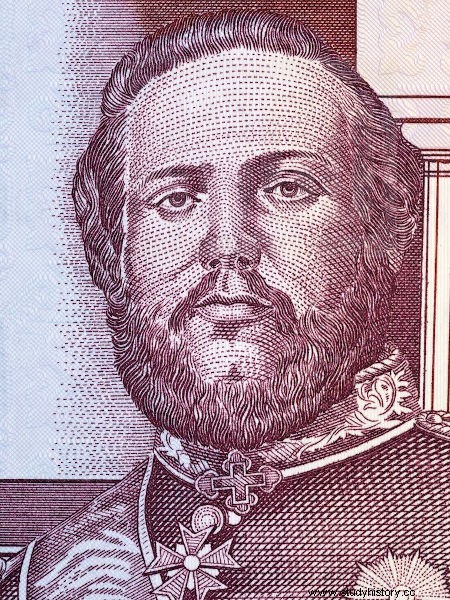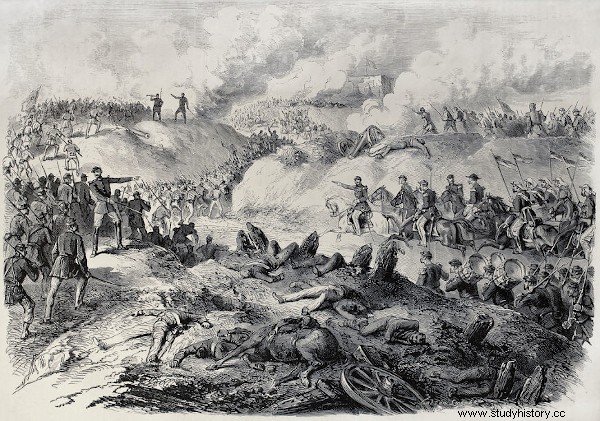The Paraguay War was a conflict that took place from 1864 to 1870 and placed Brazil, Uruguay and Argentina as allies against Paraguay. The war was caused by the different interests that existed between the Platine nations in the second half of the 19th century. The trigger for the beginning of this conflict, in the Paraguayan view, took place when Brazil invaded Uruguay to fight the blancos .
In the Brazilian perspective, the spark of the conflict occurred when the Paraguayans imprisoned a Brazilian vessel — the steamer Marquês de Olinda. In December 1864, the Paraguayans attacked Mato Grosso, and in May, Argentina, Brazil and Uruguay allied themselves through the Treaty of the Triple Alliance. Paraguay was officially defeated, and Solano López was killed in March 1870.
Read more :Proclamation of the Republic, one of the consequences of the Paraguayan War in Brazil
Causes of the Paraguayan War

The Paraguay War was the result of the process of training of the platinum nations (Brazil, Uruguay, Argentina and Paraguay) and the different economic and political interests that each nation possessed during the second half of the 19th century. The relationship between them, especially between Brazil and Paraguay, worsened during the dispute of interests fought in the War Civil Uruguayan .
The Paraguayan War is a subject that has always caused strong disagreements among historians. However, studies carried out since the 1990s led to the emergence of a new interpretation of the causes of the conflict. These new researches were carried out based on unpublished documentation and led to the emergence of what historians call a new historiography of conflict .
The causes of the Paraguayan War were mainly concentrated in the 1860s, when the different interests defended by the Paraguayan and Brazilian governments led to misunderstandings that made Paraguay attack Brazil. These disagreements intensified after the inauguration of Francisco Solano López as dictator of Paraguay in 1862.
The inauguration of Solano López brought the Paraguayan government closer to an Argentine rebel group known as the federalists . This group was led by Urquiza and was concentrated in the provinces of Entre Rios and Corrientes. Paraguay's rapprochement with the federalists made it possible for the Paraguayan government to form an alliance with the Uruguayan government, represented by the Blanco party. .
The Paraguayan approach to the Whites opened an important possibility for Paraguay to use the port of Montevideo as exit to the sea , since there was no possibility for the Paraguayans to use the one in Buenos Aires. The Paraguayan rapprochement with the Federalists displeased the Argentine government, represented by then President Bartolomé Mitre, and the Paraguayan rapprochement with the Whites in Uruguay displeased both Argentina and Brazil.
The tension between the Brazilian and Paraguayan governments already existed due to the negotiations regarding the navigation rights on the Paraguay River . The Brazilian government demanded free navigation on the rivers of the Platina Basin that cut through Paraguay, as they were the only viable means of reaching Cuiabá (there were no roads connecting the capital, Rio de Janeiro, to that city). Also, there was a territory dispute between the two countries (the dispute was over a piece of land that today corresponds to Mato Grosso do Sul).
The relationship between Brazil and Paraguay turned sour when Paraguay intervened in the war fought in Uruguay in 1864. This country, as mentioned, was ruled by the blancos — members of the political party allied to the Paraguayan government. However, the economic policy of the blanco government harmed the economic interests of the gaucho ranchers operating in Uruguay.
These began to pressure the Brazilian government to take a stand in defense of the interests of Brazilian citizens in Uruguay. Thus, the government supported Venancio Flowers , leader of the Colorado party, political opponent who fought against the blancos since 1863. Furthermore, he indicated that he would intervene directly in the conflict in favor of the Colorados.
The possibility of a Brazilian invasion of Uruguay in favor of the Colorados deeply displeased the Paraguayan government, which threatened to attack Brazil if the country intervened in the Uruguayan conflict. This firm stance by the Paraguayan government was part of a strategy, practiced by Solano López, to impose Paraguay as an alternative power in South America in an attempt to rival Brazil and Argentina.
The Brazilian government ignored the Paraguayan ultimatum and, in September 1864, led the invasion of Uruguay. Brazilian action contributed to overthrow the blanco government and place the Colorado leader, Venancio Flores, as Uruguayan president.
Conflict trigger
The Brazilian action in Uruguay angered the Paraguayan government and provoked a reprisal from Solano López. On November 11, 1864, a Brazilian vessel, the steam Marquês de Olinda , arrived in Asunción, the Paraguayan capital, with money and with the new president of Mato Grosso, Colonel Carneiro de Campos. On the grounds that the Brazilian vessel was carrying weapons, the Paraguayan government ordered the imprisonment from the vessel and all your crew .
The arrest of the Marquês de Olinda generated protests from the Brazilian government, and the Paraguayan response came with the disruption of diplomatic relations with Brazil and the ban on the passage of Brazilian vessels by the rivers that crossed Paraguay. The situation remained tense, and Solano López, believing that Brazil would attack Paraguay (which was not true), decided to attack Brazil in December 1864.
About 7700 Paraguayan soldiers they were sent to Mato Grosso, between December 22 and 24, 1864. On December 26, the Paraguayans attacked the Coimbra fort, and, on the 28th, the Brazilian troops fled. The Paraguayan attack started the Paraguayan War.
See more :Government Floriano Peixoto - the government of the military who fought during the Paraguayan War
Leaders

The Paraguay War had the participation of four countries , and numerous personalities played a crucial role in the events related to her. Here we separate the names of important characters in this scenario:
- Paraguay :Solan Lopez he was the dictator of the country and the commander of the Paraguayan troops. He fought in the war and was killed, in 1870, in the battle of Cerro Corá.
- Brazil :D. Pedro II was the emperor of Brazil. The two great names of the Brazilian army in the war were Duque from Caxias and Count D'Eu .
- Argentina :Bartolomé Miter was the Argentine president during the conflict. He saw in the war a way to consolidate his dominance in the country, putting an end to the federalists who supported Paraguay. In the course of the war, he passed the presidency to Sunday Sardment .
- Uruguay :Venancio Flowers was the president of Uruguay. He was the leader of the Colorados, the party that assumed the presidency after Brazil invaded Uruguay. He presided over the country until 1868, when he was assassinated.
Main Battles

After invading the province of Mato Grosso, the army Paraguayan headed towards the province of Rio Grande do Sul to then support the blancos in the Uruguayan Civil War. However, to reach Rio Grande do Sul and Uruguay, Paraguayan troops needed to cross Argentine territory , passing through the province of Corrientes.
As the Paraguayans were denied passage by the Argentine government, by order of Solano López, 22,000 Paraguayan soldiers invaded Argentina. This invasion brought the Brazilian and Argentine governments closer together, which led to the signing of the Triple Alliance Treaty .
In this treaty, Brazil , Argentina and Uruguay (here represented by the Colorados) united forces to fight Solano López. The treaty was officially signed on May 1, 1865, and it was decided that the war would only end with the deposition of Solano López . The three allies also discussed issues related to the new borders and the compensation that would be paid by the Paraguayans if they won the conflict.
The two armies sent by Solano López towards Rio Grande do Sul were defeated and returned to Paraguay in October and November 1865. From that moment on, the war faced by the Paraguayan army aimed to defend their territories from the Triple Alliance invaders.
The first major highlight of the struggles fought in the Paraguayan War was the Battle Naval from Riachuelo , in June 1865. In it, the Brazilian Navy destroyed almost the entirety of the Paraguayan navy, and, with that, it was able to control the navigation of the rivers of the Platina Basin, imposing a blockade that isolated Paraguay.
Another standout battle was the Battle of Curupaiti , in which the Triple Alliance troops suffered a heavy defeat, which cost at least the lives of four thousand soldiers. The facts that defined the course of the war took place in 1868, when the country's main fortress (Humaitá) was taken by Brazilian troops. Shortly thereafter, in January 1869, the Paraguayan capital (Asunción) was invaded and looted.
As Brazilian troops advanced through the interior of Paraguayan territory, Solano López's situation became more desperate. Lacking resources and soldiers, the Paraguayan dictator mobilized children and sent them to the war front. On August 16, 1689, a Paraguayan troop formed by children and adolescents was sent to face the Brazilian soldiers.
This battle became known as Grand Field Battle and or Battle of Acosta Ñú . She was part of the Allied armies' effort to pursue and capture Solano López. The fight lasted for eight hours and was marked by the fierce resistance of the Paraguayans. The result, however, was a disaster for them.
Armed with rudimentary and low quality weaponry and formed by men without military training, after the eight hours of battle, the result was a massacre. Historian Francisco Doratioto says that about two thousand Paraguayans died , among which there were many children and adolescents, and on the side of the allies only 26 deaths were recorded|1| .
Login also :Could slavery have been abolished before 1888?
Outcome of the Paraguayan War
The Paraguayan War ended definitively when the Paraguayan dictator Francisco Solano López was killed by Brazilian soldiers, in the Battle of Cerro Corá , fought in March 1870. The war left a great trail of destruction in Paraguay and contributed to the indebtedness of the Brazilian government, in addition to having marked the beginning of the decadence of the Brazilian monarchy.
As defeated, Paraguay suffered an occupation by Brazilian troops until 1876 and lost territories to Brazil and Argentina. The death tolls of the Paraguayan War are controversial and it is believed to have caused from 300,000 to 450,000 deaths, of them, about 200,000 were Paraguayans, including civilians and soldiers. Most of the deaths were caused by diseases that affected soldiers and the population during the conflict.
Note
|1| DORATIORO, Francisco. Damn war :new history of the Paraguayan War. São Paulo:Companhia das Letras, 2002. p. 417.
